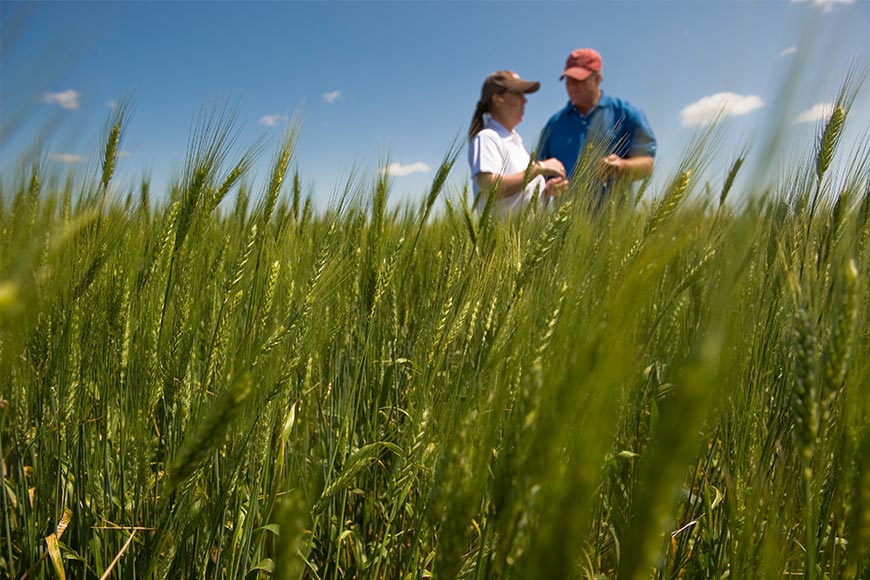Copper Is Golden for Wheat Yields

Copper is an enzyme activator that is necessary for protein production in plants. Wheat is highly responsive to copper applications in the spring as well as at flag leaf emergence.
Copper is essentially immobile in the soil, so plant uptake is accomplished by direct root interception, making this timing is critical. Additionally, copper deficiencies are most common in either high-organic-matter soils or alkaline soils with a pH of 7.5 or greater.
Assess copper levels and hit the sweet spot
The first step in assessing copper levels in wheat is to take tissue samples prior to jointing and again at flag leaf emergence. One solution to address copper deficiency in wheat is to apply copper in the form of a foliar micronutrient product absorbed by the leaves of the plant, such as MAX-IN® Copper.
When MAX-IN® Copper is applied at greenup, prior to jointing, levels in the plants are usually sufficient going into heading, allowing for only a single application. MAX-IN® Copper can be tank mixed with a variety of herbicides, fungicides and fertilizers, for added application flexibility.
WinField United research has shown that yield increases have been achieved when MAX-IN® Copper is applied when wheat is highly responsive and copper levels are commonly depleted. For example, 2015 Answer Plot® data* found that the yield response to a MAX-IN® Copper foliar application at the 4- to 5-leaf stage was 94.2 bu/A compared to an 88.8 bu/A with an in-furrow treatment of 10-34-0 alone. That’s a 5.4 bu/A increase achieved by adding MAX-IN® Copper.
Bottom line: Nutrient applications when crops are highly receptive help meet genetic yield potential and minimize unnecessary use of fertilizer.
*2015 Answer Plot® data based on eight locations in North Dakota, South Dakota, Minnesota and Montana.
- In the spring, as wheat begins to rapidly extend stem tissue, a copper deficiency may limit the amount of protein the plant needs to take up for rapid growth.
- Copper is essential for pollination and pollen tube formation, so wheat is also highly responsive to copper applications at flag leaf emergence.
- Although not a replacement for foliar fungicide, copper contributes to a wheat plant’s immune system and improves plant health.
Copper is essentially immobile in the soil, so plant uptake is accomplished by direct root interception, making this timing is critical. Additionally, copper deficiencies are most common in either high-organic-matter soils or alkaline soils with a pH of 7.5 or greater.
Assess copper levels and hit the sweet spot
The first step in assessing copper levels in wheat is to take tissue samples prior to jointing and again at flag leaf emergence. One solution to address copper deficiency in wheat is to apply copper in the form of a foliar micronutrient product absorbed by the leaves of the plant, such as MAX-IN® Copper.
When MAX-IN® Copper is applied at greenup, prior to jointing, levels in the plants are usually sufficient going into heading, allowing for only a single application. MAX-IN® Copper can be tank mixed with a variety of herbicides, fungicides and fertilizers, for added application flexibility.
WinField United research has shown that yield increases have been achieved when MAX-IN® Copper is applied when wheat is highly responsive and copper levels are commonly depleted. For example, 2015 Answer Plot® data* found that the yield response to a MAX-IN® Copper foliar application at the 4- to 5-leaf stage was 94.2 bu/A compared to an 88.8 bu/A with an in-furrow treatment of 10-34-0 alone. That’s a 5.4 bu/A increase achieved by adding MAX-IN® Copper.
Bottom line: Nutrient applications when crops are highly receptive help meet genetic yield potential and minimize unnecessary use of fertilizer.
*2015 Answer Plot® data based on eight locations in North Dakota, South Dakota, Minnesota and Montana.

